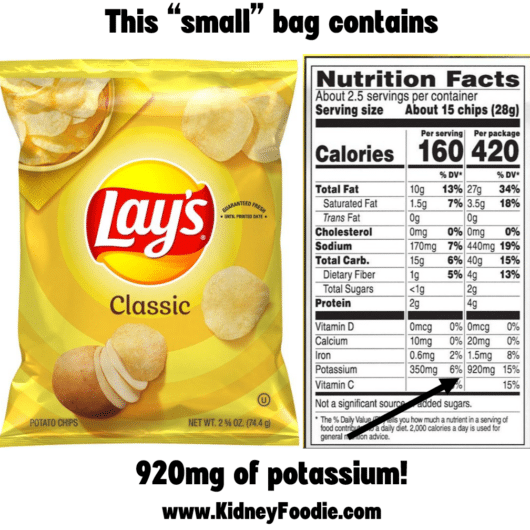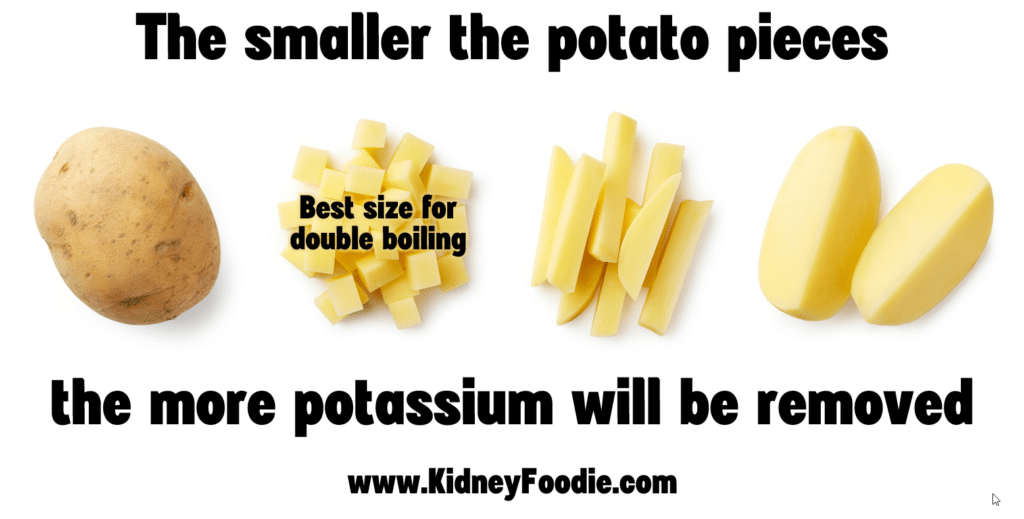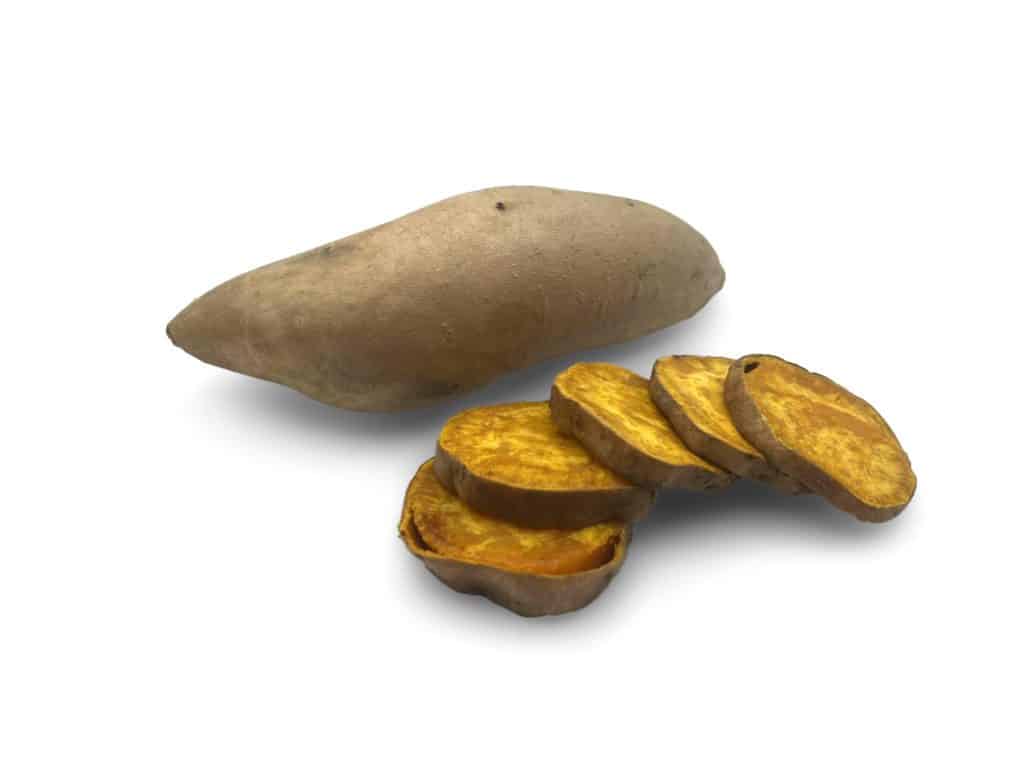Table of Contents
Are potatoes good for kidneys?
Yes, potatoes contain antioxidants, fiber, and vitamins that are beneficial to people with kidney disease. However, potatoes are high in both potassium and oxalate. If you are on a potassium restriction or are prone to developing calcium oxalate kidney stones, you should consider limiting or avoiding potatoes.
This post may contain affiliate links through which we may earn a small commission to help keep this website free.
Are potatoes high in potassium?
Yes. One half cup of cooked potatoes contains 346mg of potassium making it a high potassium vegetable. If you are on a potassium restriction, you should be mindful of your portion sizes of potatoes and potato-based products (such as potato chips).
However, if you have kidney disease, you should not restrict your intake of fruits and vegetables because of potassium content unless instructed by your kidney dietitian or healthcare provider. Many people who have kidney disease do not need to restrict their intake of potassium. There are many other factors that could cause you to have high potassium levels that are not related to the food you eat. You can learn more about potassium and kidney disease through our low cost course.
The amount of potassium in potatoes will vary depending on how they are prepared and the portion size.
A large baked potato contains about 1,600mg of potassium. That is a lot of potassium. Most kidney professionals consider a vegetable to be high in potassium if it contains more than 200mg of potassium per serving, so a large baked potato very high in potassium.
However, a large baked potato is also more than one serving. We typically consider a serving of a fruit or vegetable to be ½ cup and a large baked potato is about 5 servings.
If you were to divide that potato into 5 separate servings, then each serving would contain approximately 320mg of potassium – which would still put potatoes in the category of high potassium, but at least not as high as whole large baked potato.
Serving size is really important when considering potatoes in the kidney diet, especially if you need to limit your potassium. But serving size is also important if you have diabetes. Potatoes are starchy, and they will raise your blood sugar. If you eat a large baked potato, it’s going to raise your blood sugar A LOT. Limiting your potatoes to an appropriate portion size will help ensure that you don’t spike your blood sugar as much.
French Fries, Potassium, and Kidney Disease
One medium McDonald’s French fry has 670mg of potassium according to their website, which is a lot of potassium. Another drawback with French fries is that the vast majority of them contain phosphorus additives, including the McDonald’s fries.
A small French fry has 470mg of potassium.
A kids size French fry has 230mg of potassium.
If you’re on a potassium restriction and craving French fries, I would stick to the kids size portion and really savor those fries. The kids portion would also contain less phosphorus additives, so all the more reason to choose a smaller portion.
French Fries with no phosphorus additives
The vast majority of french fries contain a phosphorus additive to help prevent the potatoes from turning brown. There are a few frozen french fries on the market that contain no phosphorus additives:
- Whole Foods French Fries – these are also low in sodium.
- Alexia Fries – this brand does not use phosphorus additives, however their fries do have more sodium than calories. Be sure that this extra sodium fits into your daily sodium recommendation.
Potato Chips, Potassium, and Kidney Disease
One ounce is considered to be a serving size of potato chips. One ounce of potato chips will typically contain around 350mg of potassium.
A typical bag that you might find at the grocery store can contain 8 ounces. If you were to eat half a bag of potato chips, that’s 1,400mg of potassium.
And just FYI, those smaller bags that you tend to find near the checkout at stores – those are usually around 2.5-3 servings. This little bag of Lay’s chips may only have 350mg of potassium per serving, but there are 920mg of potassium in the whole bag.

So, again, be careful with your serving sizes. I’m not one to tell you that you can never have potatoes again or never have chips again, but we do need to keep the portion sizes in mind.
Mashed Potatoes, Potassium, and Kidney Disease
A serving of mashed potatoes is ½ cup, and I would encourage you to measure out your mashed potatoes the next time you eat them to get an idea of how much you’re eating because my guess is that it is probably more than ½ cup.
But a single half cup serving of mashed potatoes has about 300mg of potassium.
Double Boiling Potatoes to Remove Potassium
Now the potassium content of mashed potatoes can vary depending on what kind of potatoes you are making them with and how you make them.
In a traditional mashed potato recipe, you will boil the potatoes to get them soft before mashing. When it comes to potassium, boiling actually helps reduce the potassium content. The heat helps to break down the cell walls so potassium can be released. Potassium LOVES to spread out in water, so as the potassium is released from the cells, it likes to migrate out of the potato and into the water. So boiled potatoes will tend to be lower in potassium than potatoes cooked in dry methods like baking or roasting.
To get your potatoes even lower in potassium, you can do what’s called double boiling potatoes. The general idea is the cut your potatoes and place them in a pot of water. You should use twice as much water as potatoes. Bring the pot of water and potatoes to a boil, then drain and rinse the potatoes. Place them back in the pot and fill with twice as much fresh water, then boil again until the desired tenderness, and drain off the liquid and rinse the potatoes. If you do this, you can reduce the amount of potassium in your potatoes by about 40%.
A few key points to keep in mind when double boiling your potatoes is that the smaller the potato pieces, the more potassium will be removed. Boiling whole potatoes is not going to leach as much potassium out as using the diced potatoes. So be sure to cut them up pretty small to get the most potassium out. Second, I want to emphasize that you need to use enough water. The more water you use, the more potassium will be removed. Use twice as much water as potatoes. If you don’t use enough water, it won’t remove as much potassium. And you must be sure to change out the water when you boil the second time.

So that’s one way you can lower the amount of potassium in mashed potatoes. The double boiled mashed potatoes probably still won’t be considered a low potassium food, and they will still be high in starch, so double boiling doesn’t give you permission to eat however much you want, but it will lower the potassium in the recommended half cup portion.
Are potatoes high in phosphorus?
No. One half cup of potatoes contains about 45mg of phosphorus. The phosphorus found in potatoes is natural and poorly absorbed by the body, so it is considered a low phosphorus food.
When buying processed potato products, always check the ingredient list to see if there are any ingredients with “PHOS” in them. If you find an ingredient with PHOS in it, then that food will be considered a high phosphorus food. We recommend selecting products with no phosphorus additives.
Are potatoes high in oxalates?
Potatoes are considered high oxalate foods. A 100g portion of boiled potato has approximately 13mg of soluble oxalate. A 100g portion of potato chips has 45.8mg of soluble oxalate. (Source)
Oxalates are naturally occurring compounds found in many foods. When consumed, oxalates can bind with calcium in the body to form crystals, which can contribute to the formation of kidney stones in some individuals.
Kidney stones are hard deposits that form in the kidneys when there are high levels of certain substances, such as calcium, oxalate, and uric acid, in the urine. The most common type of kidney stone is calcium oxalate stones, which are formed when calcium and oxalate combine in the urine.
While oxalates are present in many foods, not everyone who consumes oxalates will develop kidney stones. Factors such as individual susceptibility, overall diet, and lifestyle choices play a role in kidney stone formation.
The highest oxalate fruits and vegetables are spinach, rhubarb, and swiss chard. However, it’s important to note that the mere presence of oxalates in food does not guarantee kidney stone formation. If you are not prone to developing kidney stones, then there is no reason to avoid foods that are high in oxalate.
What are the benefits of potatoes?
- Potatoes contain vitamins and antioxidants. Antioxidants consumed through fruits and vegetables are considered to have protective effects against many chronic diseases.
- Potatoes are also a good source of fiber. Fiber is important for gut health as well as helping the body maintain potassium levels.
- Research shows that a low intake of fruits and vegetables is associated with an increased risk of developing kidney failure in people with kidney disease (as well as those who don’t have kidney disease.
High and Low Potassium Fruit and Vegetable Tool
Looking for more information on other kidney friendly fruits and vegetables? Check out our Fruit and Vegetable Potassium Tool.



